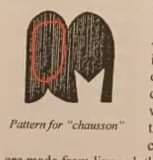Another essential piece of winter equipment is the humble chausson (pronounced “Chas-on”) or slipper in English. Today we might call them “moccasin liners” or “booties”, they even really resemble a contemporary ankle sock.
From “Costume in New France from 1740 to 1760: A Visual Dictionary” by André Gousse and Suzanne Gousse
Ok so,
here is how I’ve made chassons, I’ve never seen an actual paper pattern offered anywhere but I’ve done a lot of trial and error with muslin in order to get the fit right. Scale the pattern you get that fits correctly up or down depending on what you want them for. I use thin wool chaussons in my souliers de boeuf in the summer and thick wool chaussons in my moccasins in the winter.
The left side of the Garsault pattern is the sole and part of the heel, the right side is the top part of the chausson and the remainder of the heel.
The area circled in red is where your foot tracing would go on the pattern.
Start with a tracing of your foot in newspaper or muslin fabric or some such such and do your best to draw that basic shape . You start by drawing around your foot tracing,you want a sort of bell shape. Start the Chausson bell shape about 1/4 inch around your foot tracing. The bottom of the bell can an be about 2 inches wider than your heel.
Cut that bell shape without cutting it away from your pattern material completely and flip it over and trace it.
You should now have a shape like the McDonald’s arches.
Divide the chausson vertically and mark it with chalk etc. Measure an inch to the right and begin a line that goes to about the middle of the chausson pattern horizontally.
You will get the left hand edge of the M shape on the pattern that forms the top of the chausson and the opening to insert your foot when it’s finished. On the right hand side of the top do the same thing again.
Draw a V between these two lines with the point being half way between them to form the M shaped opening.
On the left hand sole side of the pattern we need to finish by making a w shape that will form the heel. Find the center of the heel side of the pattern and make a line an inch up from there.
Complete the w by starting on the left hand corner of the sole and draw an arch from that corner,Y to the center, X.
Then starting from the center X draw an arch that goes all the way to the left hand side of the M shaped opening marked with Z.
Cut out all along the outside, and that is your basic chausson pattern. When making a pair be sure to flip the pattern over in order to get two different feet, a left and right.
Transfer to a muslin fabric to practice and get the fit right. Adjust as needed by basting your muslin together so then you can easily take out the stitches and trace that muslin onto paper or your fabric and use it as a pattern.
I use a whip stich and wear the seams on the outside for comfort. If a bigger seam allowance is used the seams can also be flat felled.





















No comments:
Post a Comment